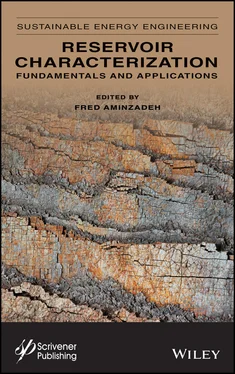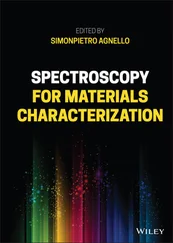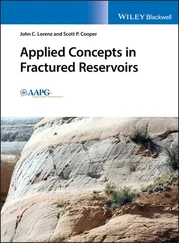1 Cover
2 Title Page Reservoir Characterization Fundamentals and Applications Edited by Fred Aminzadeh
3 Copyright
4 Foreword
5 Preface
6 Part 1: Introduction
7 1 Reservoir Characterization: Fundamental and Applications – An Overview 1.1 Introduction to Reservoir Characterization? 1.2 Data Requirements for Reservoir Characterization 1.3 SURE Challenge 1.4 Reservoir Characterization in the Exploration, Development and Production Phases 1.5 Dynamic Reservoir Characterization (DRC) 1.6 More on Reservoir Characterization and Reservoir Modeling for Reservoir Simulation 1.7 Conclusion 1.8 References
8 Part 2: General Reservoir Characterization and Anomaly Detection
9 2 A Comparison Between Estimated Shear Wave Velocity and Elastic Modulus by Empirical Equations and that of Laboratory Measurements at Reservoir Pressure Condition 2.1 Introduction 2.2 Methodology 2.3 Laboratory Set Up and Measurements 2.4 Results and Discussion 2.5 Conclusions 2.6 Acknowledgment References
10 3 Anomaly Detection within Homogenous Geologic Area 3.1 Introduction 3.2 Anomaly Detection Methodology 3.3 Basic Anomaly Detection Classifiers 3.4 Prior and Posterior Characteristics of Anomaly Detection Performance 3.5 ROC Curve Analysis 3.6 Optimization of Aggregated AD Classifier Using Part of the Anomaly Identified by Universal Classifiers 3.7 Bootstrap Based Tests of Anomaly Type Hypothesis 3.8 Conclusion References
11 4 Characterization of Carbonate Source-Derived Hydrocarbons Using Advanced Geochemical Technologies 4.1 Introduction 4.2 Samples and Analyses Performed 4.3 Results and Discussions 4.4 Summary and Conclusions References
12 5 Strategies in High-Data-Rate MWD Mud Pulse Telemetry 5.1 Summary 5.2 New Technology Elements 5.3 Directional Wave Filtering 5.4 Conclusions Acknowledgments References
13 6 Detection of Geologic Anomalies with Monte Carlo Clustering Assemblies 6.1 Introduction 6.2 Analysis of Inhomogeneity of the Training and Test Sets and Instability of Clustering 6.3 Formation of Multiple Randomized Test Sets and Construction of the Clustering Assemblies 6.4 Irregularity Index of Individual Clusters in the Cluster Set 6.5 Anomaly Indexes of Individual Records and Clustering Assemblies 6.6 Prior and Posterior True and False Discovery Rates for Anomalous and Regular Records 6.7 Estimates of Prior False Discovery Rates for Anomalous Cluster Sets, Clusters, and Individual Records. Permeability Dataset 6.8 Posterior Analysis of Efficiency of Anomaly Identification. High Permeability Anomaly 6.9 Identification of Records in the Gas Sand Dataset as Anomalous, using Brine Sand Dataset as Data with Regular Records 6.10 Notations 6.11 Conclusions References
14 7 Dissimilarity Analysis of Petrophysical Parameters as Gas-Sand Predictors 7.1 Introduction 7.2 Petrophysical Parameters for Gas-Sand Identification 7.3 Lithologic and Fluid Content Dissimilarities of Values of Petrophysical Parameters 7.4 Parameter Ranking and Efficiency of Identification of Gas-Sands 7.5 ROC Curve Analysis with Cross Validation 7.6 Ranking Parameters According to AUC Values 7.7 Classification with Multidimensional Parameters as Gas Predictors 7.8 Conclusions Definitions and Notations References
15 8 Use of Type Curve for Analyzing Non-Newtonian Fluid Flow Tests Distorted by Wellbore Storage Effects 8.1 Introduction 8.2 Objective 8.3 Problem Analysis 8.4 Use of Finite Element 8.5 Analysis Methodology 8.6 Test Data Examples 8.7 Conclusion Nomenclature References Appendix A: Non-Linear Boundary Condition and Laplace Transform Appendix B: Type Curve Charts for Various Power Law Indices
16 Part 3: Reservoir Permeability Detection
17 9 Permeability Prediction Using Machine Learning, Exponential, Multiplicative, and Hybrid Models 9.1 Introduction 9.2 Additive, Multiplicative, Exponential, and Hybrid Permeability Models 9.3 Combination of Basis Function Expansion and Exhaustive Search for Optimum Subset of Predictors 9.4 Outliers in the Forecasts Produced with Four Permeability Models 9.5 Additive, Multiplicative, and Exponential Committee Machines 9.6 Permeability Forecast with First Level Committee Machines. Sandstone Dataset 9.7 Permeability Prediction with First Level Committee Machines. Carbonate Reservoirs 9.8 Analysis of Accuracy of Outlier Replacement by The First and Second Level Committee Machines. Sandstone Dataset 9.9 Conclusion Notations and Definitions References
18 10 Geological and Geophysical Criteria for Identifying Zones of High Gas Permeability of Coals (Using the Example of Kuzbass CBM Deposits) 10.1 Introduction 10.2 Physical Properties and External Load Conditions on a Coal Reservoir 10.3 Basis for Evaluating Physical and Mechanical Coalbed Properties in the Borehole Environment 10.4 Conclusions Acknowledgement References
19 11 Rock Permeability Forecasts Using Machine Learning and Monte Carlo Committee Machines 11.1 Introduction 11.2 Monte Carlo Cross Validation and Monte Carlo Committee Machines 11.3 Performance of Extended MC Cross Validation and Construction MC Committee Machines 11.4 Parameters of Distribution of the Number of Individual Forecasts in Monte Carlo Cross Validation 11.5 Linear Regression Permeability Forecast with Empirical Permeability Models 11.6 Accuracy of the Forecasts with Machine Learning Methods 11.7 Analysis of Instability of the Forecast 11.8 Enhancement of Stability of the MC Committee Machines Forecast Via Increase of the Number of Individual Forecasts 11.9 Conclusions Nomenclature Appendix 1- Description of Permeability Models from Different Fields Appendix 2- A Brief Overview of Modular Networks or Committee Machines References
20 Part 4: Reserves Evaluation/Decision Making
21 12 The Gulf of Mexico Petroleum System – Foundation for Science-Based Decision Making Introduction Basin Development and Geologic Overview Petroleum System Reservoir Geology Hydrocarbons Salt and Structure Conclusions Acknowledgments and Disclaimer References
22 13 Forecast and Uncertainty Analysis of Production Decline Trends with Bootstrap and Monte Carlo Modeling 13.1 Introduction 13.2 Simulated Decline Curves 13.3 Nonlinear Least Squares for Decline Curve Approximation 13.4 New Method of Grid Search for Approximation and Forecast of Decline Curves 13.5 Iterative Minimization of Least Squares with Multiple Approximating Models 13.6 Grid Search Followed by Iterative Minimization with Levenberg-Marquardt Algorithm 13.7 Two Methods for Aggregated Forecast and Analysis of Forecast Uncertainty 13.8 Uncertainty Quantile Ranges Obtained Using Monte Carlo and Bootstrap Methods 13.9 Monte Carlo Forecast and Analysis of Forecast Uncertainty 13.10 Block Bootstrap Forecast and Analysis of Forecast Uncertainty 13.11 Comparative Analysis of Results of Monte Carlo and Bootstrap Simulations 13.12 Conclusions References
23 14 Oil and Gas Company Production, Reserves, and Valuation 14.1 Introduction 14.2 Reserves 14.3 Production 14.4 Factors that Impact Company Value 14.5 Summary Statistics 14.6 Market Capitalization 14.7 International Oil Companies 14.8 U.S. Independents 14.9 Private Companies 14.10 National Oil Companies of OPEC 14.11 Government Sponsored Enterprises and Other International Companies 14.12 Conclusions References
24 Part 5: Unconventional Reservoirs
25 15 An Analytical Thermal-Model for Optimization 15.1 Introduction 15.2 Mathematical Model 15.3 Model Comparison 15.4 Sensitivity Analysis 15.5 Model Applications 15.6 Conclusions Nomenclature Acknowledgements References Appendix A: Steady Heat Transfer Solution for Fluid Temperature in Counter-Current FlowAssumptions Governing Equation Boundary Conditions Solution
26 16 Development of an Analytical Model for Predicting the Fluid Temperature Profile in Drilling Gas Hydrates Reservoirs 16.1 Introduction 16.2 Mathematical Model 16.3 Case Study 16.4 Sensitivity Analysis 16.5 Conclusions Acknowledgements Nomenclature References
Читать дальше








